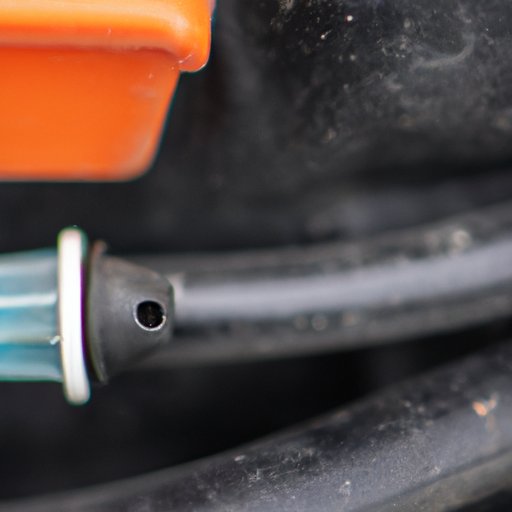
Introduction
Your car’s engine is a complex machine, with various sensors and components working together to keep it running smoothly. One such sensor is the manifold absolute pressure (MAP) sensor, which measures the amount of air entering the engine. If this sensor is faulty, it can cause a range of issues that affect your car’s performance.
In this article, we’ll explore the symptoms of a faulty MAP sensor and what you can do to address the issue. We’ll also discuss the importance of diagnosing the problem promptly to prevent future complications.
Identifying the Signs of a Faulty Map Sensor: A Comprehensive Guide
Before we dive into the signs of a faulty MAP sensor, let’s first define what it is and what it does. The MAP sensor measures the changes in intake manifold pressure and sends this information to the engine control module (ECM). The ECM then uses this data to calculate the correct fuel delivery and ignition timing for optimal engine performance.
One of the most common symptoms of a faulty MAP sensor is an engine that runs rough. This can manifest as a shuddering or vibration felt throughout the vehicle, or as a rough idle when the car is stationary. Additionally, a faulty MAP sensor can cause your car to have poor fuel economy, as it’s not receiving accurate information about the amount of air entering the engine.
In real-life scenarios, these signs can present themselves in a variety of ways. For example, if you notice your car running roughly when idling at a stop sign, it may be due to a faulty MAP sensor. Similarly, if you find yourself needing to fill up at the gas pump more often than usual, this could also be a sign that your sensor needs replacing.
Don’t Ignore These Symptoms of a Faulty Map Sensor
While a rough-running engine and poor fuel economy are cause for concern, there are more alarming symptoms that indicate a faulty MAP sensor. These include engine misfires, stalling, and difficulty starting the engine.
It’s essential to address these symptoms as soon as possible, as they can cause your car to stop running altogether. If you’re experiencing any of these issues, it’s crucial to take your car to a mechanic right away for diagnosis and repair.
5 Common Indications of a Faulty Map Sensor in Your Car
In addition to the symptoms we’ve already discussed, here are some specific signs that your MAP sensor may be faulty:
1. Check engine light: If your car’s onboard diagnostics system detects an issue with the MAP sensor, it will trigger the check engine light to come on.
2. Loss of power: A faulty MAP sensor can cause your car to lose power or acceleration, particularly when going uphill or at high speeds.
3. Rich or lean condition: If the MAP sensor is providing incorrect information to the ECM, it can cause the engine to run too rich or lean, which can result in decreased performance, increased emissions, and other issues.
4. Rough shifting: A faulty MAP sensor can cause your car’s transmission to shift roughly or erratically, as it’s not receiving consistent information about the engine’s performance.
5. Increased emissions: As we mentioned earlier, a faulty MAP sensor can cause your car to run too rich or lean, resulting in increased emissions that can harm the environment.
Is Your Car’s Map Sensor Causing These Problems? Here’s How to Know
If you suspect your car’s MAP sensor may be faulty, there are a few steps you can take to diagnose the issue. First, you’ll need to use a diagnostic tool to read the codes from your car’s onboard diagnostics system. This tool will tell you if there are any issues with the MAP sensor or other components.
Additionally, you can visually inspect the MAP sensor for any signs of damage or wear. Look for cracks, corrosion, or other signs of physical damage that may be causing the sensor to malfunction.
It’s important to note that you shouldn’t assume the MAP sensor is the issue without proper diagnosis. Other components, such as the oxygen sensor or air intake system, can cause similar symptoms, so it’s always best to get a professional diagnosis before replacing any parts.
Understanding How a Map Sensor Works: Signs of Failure to Look Out For
To understand why a faulty MAP sensor can cause the symptoms we’ve discussed, it’s essential to know how the sensor works. The MAP sensor measures the amount of air entering the engine and sends this information to the ECM. Based on this data, the ECM delivers the correct amount of fuel and ignition timing for optimal engine performance.
If the MAP sensor is faulty, it may send incorrect information to the ECM, causing the engine to run poorly. Additionally, a faulty MAP sensor can cause the engine to get too much or too little fuel, resulting in poor fuel economy or increased emissions.
The Importance of Diagnosing a Faulty Map Sensor: Warning Signs You Shouldn’t Ignore
We can’t stress enough the importance of diagnosing and addressing a faulty MAP sensor promptly. Ignoring the symptoms we’ve discussed can lead to more severe issues down the line, such as engine damage or failure, which can be costly to repair.
One way to prevent future issues with your MAP sensor is to perform regular maintenance, such as checking for air leaks or cleaning the sensor. Addressing related issues, such as a clogged air filter or a damaged vacuum line, can also help prevent sensor failure.
Conclusion
In conclusion, a faulty MAP sensor can cause a range of issues for your car’s performance, from poor fuel economy to engine stalling. By knowing the signs of a faulty sensor and diagnosing the issue promptly, you can prevent more severe problems down the line and keep your car running smoothly. Don’t hesitate to take your car to a mechanic if you suspect an issue with your MAP sensor, and remember to perform regular maintenance to prevent future complications.





